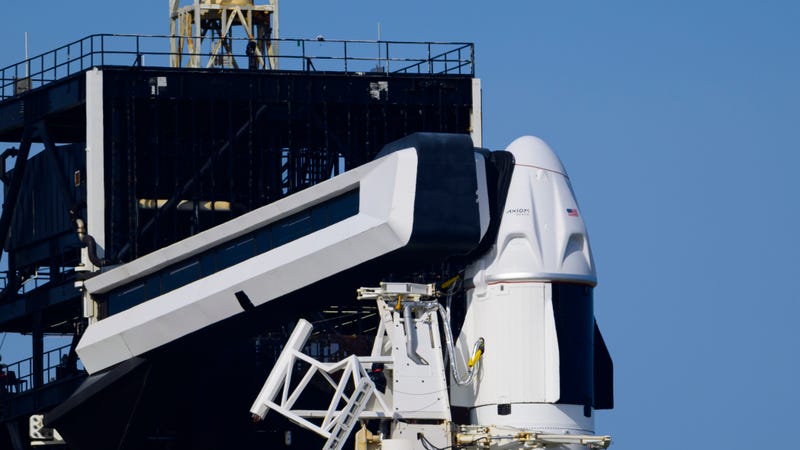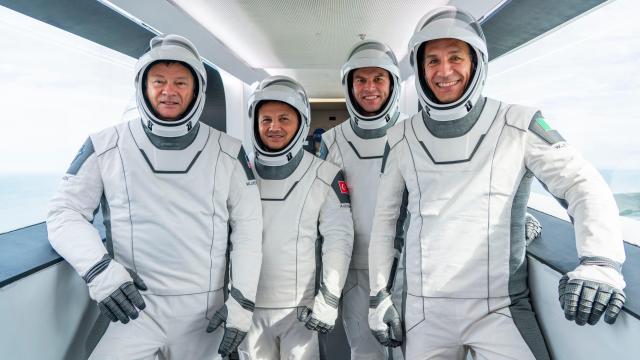The third private mission to the International Space Station (ISS) is getting ready to launch an all-European crew, along with dozens of scientific experiments, to low Earth orbit.
Axiom Mission 3 (Ax-3) is scheduled for liftoff on Thursday, January 18 at 8:49 p.m. AEDT from NASA’s Kennedy Space Center in Cape Canaveral, Florida. The launch was originally scheduled for later today, but additional time was needed for teams to “complete pre-launch checkouts and data analysis on the vehicle,” according to SpaceX. Axiom Space’s third commercial spaceflight will launch on board SpaceX’s Falcon 9 rocket and the Dragon spacecraft Freedom, carrying a crew of four private astronauts for a two-week mission.
Here’s what you need to know about Axiom’s upcoming flight.
How to watch the Ax-3 launch?
Axiom will broadcast the launch live through its YouTube Channel, and you can also tune in through the live feed below.
NASA will also livestream the launch through NASA TV and the space agency’s website. SpaceX will host its own broadcast through the company’s account on X around two hours before launch time.
Who is launching on board Ax-3?
The mission will launch a four-person crew to the space station. Former NASA astronaut and Axiom’s current chief astronaut, Michael López-Alegría, will serve as commander of the mission. López-Alegría also commanded Axiom Space’s first private mission to the ISS in April 2022.
Walter Villadei, an Italian Air Force officer, will serve as the mission’s pilot. He’s no stranger to private missions, having flown on board Virgin Galactic’s first commercial flight in June 2023.
The two mission specialists are Turkey’s soon-to-be first astronaut Alper Gezeravcı and European Space Agency’s (ESA) astronaut reserve member Marcus Wandt of Sweden.
What will Ax-3 astronauts do on board the ISS?
Each member of the crew will represent their country on board the ISS, carrying out scientific research to serve their national interests. The Dragon spacecraft will be packed with more than 30 experiments from Italy, Turkey, and Sweden. The Italian Space Agency’s AstRNAuts project is designed to track the molecular signatures of biomarkers that change in response to the space environment, while its LIDAL experiment will evaluate the potential risks posed by high-energy particles on the ISS.

Turkey’s MESSAGE (Microgravity Associated Genetics Research Group) project aims to study changes in gene expression related to microgravity in human immune system T-cells. These cells will be collected from an astronaut on the ISS for the assessment. ESA will also be launching its Sleep in Orbit project, which will investigate the effects of sleeping in microgravity by monitoring sleep patterns in space and comparing them to sleep on Earth using in-ear electroencephalogram (EEG) equipment.
How many private missions have flown to the ISS?
This will mark Axiom Space’s third private mission to the ISS.
The first private mission to the ISS arrived at the orbiting station in April 2022, and the four Ax-1 crew members spent 15 days living and working in the microgravity environment. Ax-2 launched a little over a year later, sending another private crew to the ISS in May 2023.
Ax-3 was originally scheduled to launch in November 2023 but NASA and Axiom Space delayed the mission to allow “for teams to collaborate on the integration of the mission’s scientific research priorities,” the space agency wrote.
NASA has already tapped Axiom Space for a fourth mission to the ISS.
Why is NASA flying private astronauts to the ISS?
The private missions to the ISS are meant to transition low Earth orbit to a commercial platform after the aging space station retires in 2030.
Axiom Space is designing its own space station, with plans to launch the first module to low Earth orbit in 2025. With the launch of its Axiom station modules, the company wants to start sending its crews up at will, eliminating the requirement for NASA to approve its missions.
That being said, the first private mission to the ISS wasn’t all smooth sailing. The Ax-1 crew complained that they were overworked on board the space station, and they sometimes interfered with the work of regular ISS astronauts. Upon their return, NASA admitted to having learned some important lessons from that first mission that it’s now regularly implementing for private ISS missions.
